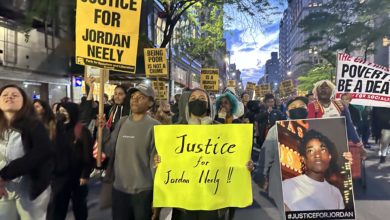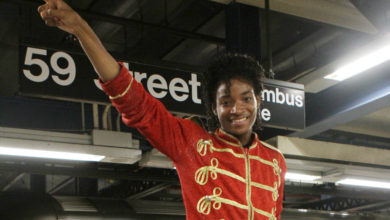Photo: The February One monument on North Carolina Agricultural and Technical State University’s campus. Credit —
The following article was originally published in 2010 to mark the 50th anniversary of the heroic sit-ins
On Feb. 1, 1960, Ezell A. Blair Jr., David Leinhail Richmond, Joseph Alfred McNeil, and Franklin Eugene McCain entered their local Woolworths store in Greensboro, N.C. The four students at North Carolina Agricultural and Mechanical University purchased some school supplies, then sat down at the lunch counter to order coffee.
They stayed until closing time, and yet were never served. Why? Because the four students were Black, and the lunch counter was segregated.
Store management, hoping to avoid an incident, allowed the young men to leave without having them arrested. However, the students returned the next morning, joined by others. From 11 a.m. to 3 p.m., they sat doing school work and waiting in vain to be served. This time, the local news media covered their “sit-down” protest.
On Feb. 3, the A&T students were joined by students from Bennett College, a college for Black female students, who had been discussing targeting Woolworths themselves. Together, they mobilized 60 students that day to occupy every space at the Woolworths counter to demand equal service. The local Ku Klux Klan also turned out. They heckled and harassed the students.
But the students were undeterred. Determined to smash racist Jim Crow laws, students from a number of area colleges and high schools began to join the movement, with sit-in protesters occupying the lunch counter, and hundreds picketing outside of Woolworths demanding equal service regardless of race.
It was the beginning of a struggle that would bring large numbers of Black students and youth into the civil rights movement and draw nationwide attention.
Black students elsewhere took notice of the Greensboro events. Students across North Carolina in cities such as Raleigh began organizing their own sit-ins. On Feb. 10, students at Hampton University in Virginia launched their own campaign to desegregate lunch counters. Students in Rock Hill, S.C., and Nashville, Tenn., followed suit on Feb. 12 and 13.
By April, the protests had reached every southern state and spread north and west. Black and white students picketed Woolworths to demand they end their discriminatory practices in southern stores. By year’s end, over 70,000 students had taken part in sit-in demonstrations in over 100 different locations around the country.
In July 1960, Woolworths agreed to serve anyone regardless of race. Nevertheless, the genie was out of the bottle. While there had been successful sit-in campaigns before, most notably in Oklahoma City in 1958, none had captured the national imagination the way Greensboro had. Black students across the country had fired their shot across the bow, and the days of Jim Crow were numbered.
From emancipation to Jim Crow
Following the end of the Civil War in 1865, federal troops continued to occupy the southern states in a period known as Reconstruction. This period witnessed a number of sweeping progressive gains for African Americans in the field of political rights, civil rights and education, among others.
The ruling Republican Party brought together a coalition of capitalists, freedmen, and farmers—the coalition that had been key to victory in the war.
Both during and after the war, however, the primary concern of the capitalist elements who had led the Republican coalition was to secure a stable environment for their investments. To this end, they aimed to break the slavocracy’s resistance to innovation and infrastructure improvements that prevented the creation of a true national market where they could sell goods and hire “free” wage labor.
In a bid to maintain their political power and ability to shape the direction of the country, the capitalist leaders of the Republican Party betrayed the freedmen in 1877, ending the Reconstruction period. The southern economy, which had been turned into a virtual economic colony of the North, was left untouched. The end of Reconstruction in 1877 ushered in the racist reaction that gave birth to Jim Crow laws.
Using racist fear-mongering and terror, a political elite made up of former Confederate leaders and other well-to-do Southerners were able to maximize their own economic and political gains by returning African Americans to the status of second-class citizens. The system of segregation was further strengthened and made absolute following the defeat of the Populist movement, which for a period united Black and white tenant farmers. A new set of legal codes combined with violent repression had fully disenfranchised African Americans by the turn of 20th century.
Student Non-violent Coordinating Committee
These were the historical roots of the oppression faced by African Americans in the southern states in 1960, when the vile institution of segregation was still promoted by corporations, landlords and the rich who benefitted from the deeply divisive racism.
Shortly after the Greensboro sit-ins, students around the country founded the Student Non-violent Coordinating Committee, which initiated mass campaigns against segregation all across the South. The Greensboro sit-ins invigorated the entire Civil Rights movement, and were the opening salvo for a number of local and national mass campaigns that would eventually bring down legal segregation and win other gains.
The Greensboro students demonstrated the necessity of a determined struggle to effectively challenge Jim Crow segregation. Students were willing to be arrested, harassed, and even risk death to reclaim their human dignity. Left alone, the capitalists and their political agents would have remained committed to maintaining the status quo.
These are lessons we can and must heed today. Fifty years on, the Greensboro sit-in movement stands as a testament to the critical role of sustained mass action as a vehicle for social change.






